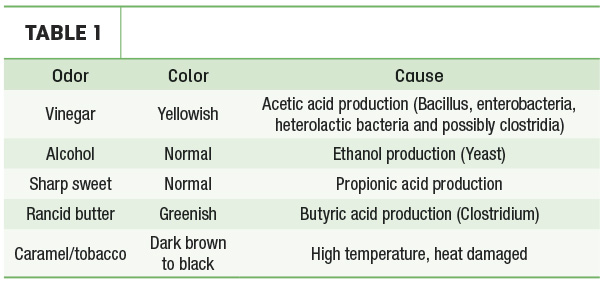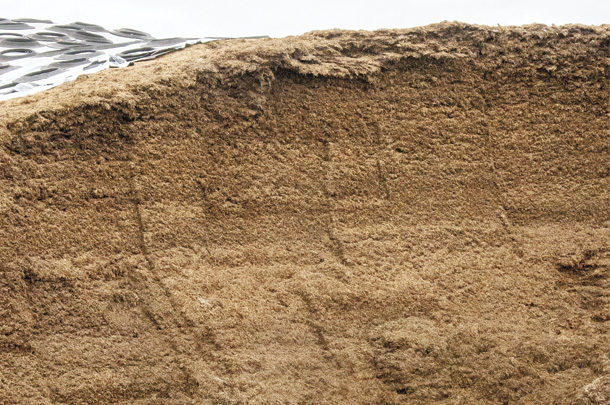At its best, the process of ensiling should retain as much valuable nutrients and dry matter (DM) from the original forage crop as possible. Once the crop is chopped, that’s as good as the silage quality will ever get. Even in excellent operations, weather doesn’t always cooperate to hit the perfect harvest window, or equipment breaks at the most inopportune moment. Even in less-than-ideal scenarios, there are options for dealing with unhygienic silage.
Prevent the worst-case scenario
Let’s get the bad news out of the way first. The most effective way to deal with spoiled silage is to prevent it from happening in the first place. Take a hard look at your silage management practices. My colleagues have provided more detail about critical areas in the previous two articles in this series.
Have contingency plans – plan B, C and even D – in place for any unforeseen adverse event that might occur. It is better to have contingency plans in place and not need them than to have an adverse event and scramble to figure out “What now?” Time is of the essence at harvest. The world is not going to stop and wait for you to get on. Take time now to list adverse events that have been experienced in the past or may happen in the future. Then, plan what you would do when it happens again; it probably will.
Public enemy No. 1 for silage already in the silo is yeast. Yeast contamination is the primary driver regarding lack of silage preservation and decreasing aerobic stability. One study showed that a differential temperature of greater than 9 degrees Fahrenheit between the core (16 inches deep) and the surface (6 inches) depth corresponded to a 5-log difference in yeast count. That is a huge difference – a 100,000 times difference.
Ideally, producers should acknowledge when harvest conditions are less than ideal and have a plan to counter the conditions. In these cases, it can pay to use a combination forage inoculant, such as those including Lactobacillus buchneri NCIMB 40788 applied at 400,000 colony-forming units (CFU) per gram of silage or 600,000 CFU per gram of high-moisture corn (HMC). It has been uniquely reviewed by the FDA and allowed to claim improved aerobic stability, which makes it perfect for scenarios where producers anticipate a challenging fermentation and risk of aerobic instability at feedout.
Another source of contamination is from the tires on the trucks and tractors during harvest or during feedout. Undesirable substances can be tracked into the silage. This can lead to a whole host of issues depending on what is introduced into the silage. Everything that can be done should be done to maintain the hygienic quality of the feed being preserved.
Evaluate silage color and smell
Silage color and smell can indicate potential fermentation problems. It is important to determine what the nature of the challenge is before determining the next step (Table 1).

Darkened silage usually indicates heating. These silages have the highest potential for opportunistic microbes such as molds and are typically unacceptable feeds. Mold growth can cause palatability issues and reduce animal performance. Plus, some molds can produce mycotoxins under certain circumstances. It is the wild yeast fermenting that creates the optimal conditions for mold growth in silage.
A clostridial fermentation will likely result when alfalfa, grass or cereal grain silages are harvested at higher-than-recommended moisture levels and ensiled without a good inoculant. This leads to the creation and accumulation of butyric and acetic acids, and biogenic amines and ammonia.
Studies in ruminally and abomasally cannulated steers show that dry matter intake (DMI) decreased by more than 25% as the levels of putrescine and cadaverine – which are two biogenic amines – increased in the diet.
Throw it out
Most often, visibly moldy silage is not redeemable, and producers would do better to just throw it out. Field case reports show that feeding even small amounts of spoiled silage can lead to reproduction and respiratory problems, herd health issues, reduced feed intake and decreased production.
A Kansas State University study in beef cattle showed including even 25% spoiled silage (as part of a 90% silage ration) had negative effects on nutrient digestibility, and the integrity of the forage mat in the rumen was destroyed.
Dilute and feed to a less sensitive group
As a rule, dilution is not the solution to pollution. Choosing to feed out spoiled silage to highly productive herds will inevitably result in lowered feed intake and a drop in production. When fed unpalatable silage, cattle will not eat as much quantity. Plus, what they do eat will be lower in important nutrients.
However, small amounts of silage can be fed to a less productive group, such as non-lactating, younger cattle. Do not feed it to dry cows. Take care to use good face management techniques to ensure additional spoilage is not occurring during feedout.
Support the rumen
There are still opportunities to recover your herd’s health and productivity even if spoiled silage made it all the way to the feedbunk.
First, stop feeding the silage and obtain a forage analysis. There may be occasions that merit a more detailed wet chemistry fermentation profile analysis along with mold and yeast counts. This can help you understand if there are mycotoxins present and the specific type.
Next, anticipate rumen challenges in the herd, including sub-acute ruminal acidosis (SARA). Consider adding a rumen-specific active dry yeast to optimize rumen function and support lower gut health.
High-performing herds are very similar to elite athletes. A bad meal or two can knock them off the top of their game. It is much easier to create high-quality silage and enjoy the benefits of health and productivity year-round.
Editor’s Note: This is the final article in a three-part series on forage hygiene. The previous articles "Clean up your act: High-quality, hygienic silage starts in the field" and "Creating silage cattle need (and want) to eat."








